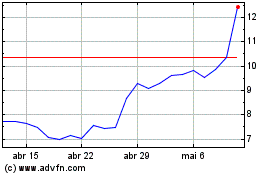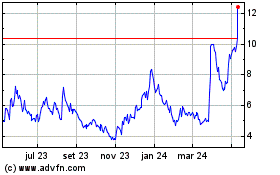U.S. index futures advanced in pre-market trading on Tuesday,
signaling a recovery after a volatile week. Investors are eagerly
awaiting inflation reports, which could provide clarity following
recent market fluctuations. The Producer Price Index (PPI) will be
released today, with the Consumer Price Index (CPI) scheduled for
Wednesday.
At 4:47 AM ET, Dow Jones futures (DOWI:DJI) were up 64 points,
or 0.17%. S&P 500 futures gained 0.35%, and Nasdaq-100 futures
rose 0.56%. The 10-year Treasury yield was at 3.921%.
In commodities, oil prices are falling, breaking a five-day
streak of gains, after OPEC cut its demand growth forecast for
2024, citing weak demand in China. Global demand concerns and
potential changes in OPEC+ production also contributed to the
decline, with investors watching geopolitical tensions and upcoming
U.S. inflation data.
West Texas Intermediate crude for September fell 0.29% to $79.83
per barrel, while Brent crude for October dropped 0.30% to $82.05
per barrel.
On the U.S. economic calendar for Tuesday, at 6:00 AM, the NFIB
Small Business Optimism Index for July will be released, expected
to remain at 91.5 points. At 7:30 AM, the July Producer Price Index
(PPI) will be released, with an expected increase of 0.2%, as well
as the core PPI. Yearly PPI and core PPI data, previously at 2.6%
and 3.1%, respectively, will also be reported.
According to a survey by the Federal Reserve Bank of San
Francisco, middle- and low-income U.S. households have
significantly fewer liquid assets than before the pandemic. In
contrast, high-income households have seen a partial recovery of
these assets. This deficit, coupled with rising credit card
delinquencies, pressures consumer spending and raises concerns
about Fed interest rate policies.
Asia-Pacific markets showed mixed results. In Japan, the Nikkei
225 surged 3.45%, reaching 36,232.51 points, while the Topix
climbed 2.83%, closing at 2,553.55. The rise was driven by the tech
and financial sectors. South Korea’s Kospi increased by 0.12% to
2,621.50, while the Kosdaq fell by 1.02% to 764.86. In Australia,
the S&P/ASX 200 rose by 0.16% to 7,826.8. In China, the CSI 300
advanced by 0.26% to 3,334.39, and the Hang Seng gained 0.32% by
the end of the day.
In Japan, wholesale inflation in July rose 3% year-over-year,
the largest increase in 11 months, due to yen weakness driving up
import costs. The corporate goods price index hit a record 123.1,
marking the eighth consecutive month of record highs, compared to
2.9% in June. The Bank of Japan, which raised interest rates to
levels not seen in 15 years, is closely monitoring this data.
Additionally, the yen-based import price index rose by 10.8% in
July, reflecting yen weakness and rising commodity prices.
In Australia, wages increased by 0.8% in the quarter ending in
June, the slowest pace in a year and below forecasts of 0.9%.
Annual wage growth remained at 4.1% but is expected to slow. The
private sector saw growth of just 0.7%, the slowest since December
2021, reflecting a sluggish labor market recovery.
In July, business conditions in Australia improved, with the
index rising to +6, while the confidence index fell to +1.
Employment recovery lifted the employment index to +7, but sales
dropped. The survey showed a slowdown in price pressures, with
purchase costs and product prices slowing down, though labor costs
increased.
Singapore’s economy grew by 2.9% in the second quarter, meeting
the official estimate and exceeding expectations. The government
adjusted the 2024 GDP growth forecast to 2.0%-3.0%. Quarterly
growth was 0.4%. External demand is expected to remain strong, but
geopolitical and financial risks persist.
European markets rose, with utilities leading gains, while
travel stocks declined. Wages in the U.K. grew 5.4% year-over-year
in the second quarter, the slowest rate in two years. The
unemployment rate fell to 4.2%, below the expected 4.5%. Jack
Kennedy of Indeed stated that the labor market remains tight and
wage pressures are easing slowly, limiting rate cuts by the Bank of
England. U.K. inflation data is due Wednesday, with expectations
that the headline rate will rise to 2.3%.
On Monday, U.S. stocks fluctuated, with the Dow Jones falling
0.36%, the Nasdaq rising 0.21%, and the S&P 500 remaining
almost flat. Volatility was driven by anticipation of important
economic reports that could influence the Federal Reserve’s
interest rate decisions. Among individual stocks,
JetBlue (NASDAQ:JBLU) fell 20.7% after announcing
the issuance of $400 million in convertible notes. Weakness in
airline and telecom stocks contrasted with gains in gold
stocks.
In the quarterly earnings front, The Home
Depot (NYSE:HD), Melco Resorts &
Entertainment (NASDAQ:MLCO), Sea
Limited (NYSE:SE), Hut 8
Mining (NASDAQ:HUT), Paysafe (NYSE:PSFE), MindMed (NASDAQ:MNMD), Intuitive
Machines (NASDAQ:LUNR), Hyzon
Motors (NASDAQ:HYZN), Tencent Music
Entertainment Group (NYSE:TME), among others, will
report before the market opens.
After the close, numbers are expected from Nu
Holdings (NYSE:NU), SurgePays (NASDAQ:SURG), Ouster (NYSE:OUST), Gold
Royalty (AMEX:GROY), Zevra
Therapeutics (NASDAQ:ZVRA), Intapp (NASDAQ:INTA), Avino
Silver & Gold
Mines (AMEX:ASM), Franco-Nevada (NYSE:FNV, Silvercorp
Metals (AMEX:SVM), Oncology
Institute (NASDAQ:TOI), and more.
Ouster (NYSE:OUST)
Gráfico Histórico do Ativo
De Dez 2024 até Jan 2025

Ouster (NYSE:OUST)
Gráfico Histórico do Ativo
De Jan 2024 até Jan 2025
